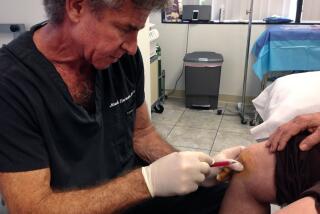San Diego company studies stem cell implant as a Type 1 diabetes treatment
- Share via
A pouch full of brand-new cells may one day reduce the need for people with Type 1 diabetes to take daily insulin shots.
ViaCyte Inc. of San Diego has already used its technique to cure diabetes in hundreds of mice, says Eugene Brandon, one of the company’s directors. ViaCyte hopes to begin human trials of its implants, which are made from embryonic stem cells, by 2013, aided by $26 million in grants and loans from the California Institute of Regenerative Medicine, the state’s stem cell funding agency.
The treatment is aimed at people with Type 1 diabetes, who typically fall ill as children or young adults when their bodies attack the insulin-producing beta islet cells in the pancreas. Type 1 diabetes affects between 1 million and 3 million Americans.
People with Type 1 diabetes rely on insulin injections or an insulin pump to regulate their blood sugar. It works, but it’s inconvenient, says Dr. Vivian Fonseca of Tulane University in New Orleans, the American Diabetes Assn.’s president-elect for medicine and science. Better therapies, he says, are sorely needed.
ViaCyte’s plan is to slip a an envelope filled with pancreatic cells under the skin. These pancreatic cells would turn into beta islet cells.
“We’re essentially creating a replacement pancreas,” Brandon says.
Embryonic stem cells can turn into any other kind of cell. Type 1 diabetes, researchers say, is a particularly appealing target for stem cell treatments because only one cell type needs to be replaced. The issue is trickier for people with Type 2 diabetes, because they do make insulin — their body just doesn’t respond to it properly. But even with this group, Brandon says, the treatment may have potential for the fraction of, Type 2 diabetes patients who use extra insulin to control their blood sugar.
Over the last decade, ViaCyte has learned how to make what it calls pro-islet cells: ones that are on the way to becoming islet cells but haven’t fully matured. The company started with stem cells from blastocysts — very early stage embryos — that were destined for destruction at a fertility clinic. It then used natural growth factors to encourage the cells to turn into pancreatic cells. Once under a mouse’s skin, the cells mature into beta islet cells. After a couple of months, they start making insulin.
Brandon hopes the implants would work the same in people.
But simply dropping stem cells into a person is fraught with uncertainty. The cells might become the wrong type. Many researchers worry that stem cells could form tumors. Additionally, the recipient’s immune system will attack the new cells.
To sidestep those issues, ViaCyte has developed a thin membrane envelope that allows sugar in and insulin out. But the cells can’t escape, and cells of the immune system can’t get in to attack them. Doctors could monitor the cells via ultrasound and remove the device if there were any problem.
“The safety factor is pretty high,” says Alan Trounson, president of CIRM.
In mice lacking islet cells, the device successfully delivers insulin and controls blood sugar for more than a year, which is the lifetime of the animal, Brandon says. He hopes the transplanted cells would last for many years in people, although he speculates that people with diabetes would still want to sign up even if they had to get a replacement every six months or so.
The approach looks promising, Fonseca says, although he’s reserving judgment until human tests are done.
The first trials will test the safety of the implant in a handful of people. Though ViaCyte is in an ongoing patent dispute over part of the stem cell procedure with Geron Corp. in Menlo Park, Calif., Brandon says the clinical trial will go ahead regardless of outcome. Should Geron prevail, ViaCyte would pay to license the protocol, he says.
The stem cell approach is one of several that are aimed at getting people with Type 1 diabetes off the insulin pump.
Pancreatic transplants are an option, usually in extreme cases. It’s major surgery, and recipients have to take immune-suppressing drugs so that their bodies do not attack the transplant. Half of the transplants fail, and 10% to 20% of recipients die within a year, according to the American Diabetes Assn.
An alternative is to simply transplant islet cells into the liver, which is easy to reach via a tube. It’s a safer, relatively minor procedure, but immune blockers are still necessary. For most people, it does not fully relieve the need for insulin shots.
The main problem with either approach, Fonseca says, is that “there are not enough islets to go around.” He estimates an islet transplant requires cells from five organ donors.
Another tactic is to wipe out the diabetic person’s immune system and then restore it with blood stem cells that form a new immune system. The new immune system should not attack beta cells like the old ones did. Researchers in Brazil have reported using this treatment on a trial basis in more than 20 people with diabetes. Many participants lived without insulin injections for nearly three years before they required supplemental insulin again.
But these data are preliminary, and destroying and rebuilding the immune system is a serious procedure.
Researchers can also try to force the pancreas to make more islet cells, but it’s too early to know if this will work, Trounson says.
“What people want is a single, one-time cure,” Fonseca says. “I don’t see that happening in the foreseeable future.” But, he adds, stem cell treatments might be a step in the right direction.
More to Read
Sign up for The Wild
We’ll help you find the best places to hike, bike and run, as well as the perfect silent spots for meditation and yoga.
You may occasionally receive promotional content from the Los Angeles Times.










